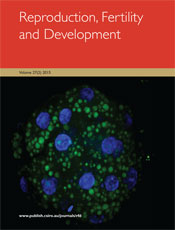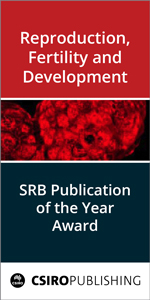Reproduction, Fertility and Development
Volume 27
Number 2 2015
Fertility can be recovered from birds’ ovaries using transplantation. Fragments of ovaries from adult Japanese quail were transplanted into week-old quail recipients and chicks were produced from the donor tissue, demonstrating that adult birds can be used as ovarian donors for genetic conservation. Changes in egg production with the transplants also suggested that ovarian transplantation can be used to study reproduction in birds.
Sperm from different stallions exhibit great differences in cryosurvival rates, which likely can be attributed to differences in cellular properties, such as membrane stability towards osmotic stress. The aim of this study was to obtain insights in factors determining membrane stability as well as cryosurvival. Pre-freeze osmotic tolerance was evaluated for individual stallions, and it was found that this cannot be used as a parameter to predict sperm cryosurvival rates.
Our research focused on the mechanism of meiosis initiation, a complex process that is still not clear. In this study, we cultured 11.5 days post coitum female mouse genital ridges in vitro with exposure to Brefeldin A and found that meiosis initiation was stimulated partly via a retinoic acid–Stra8 signal. Our results contributed to the study of meiosis initiation in vitro and also confirmed the role of Stra8 in meiosis initiation.
Post-weaning treatments with a progesterone analogue can be applied in sows to postpone oestrus after weaning, which may affect subsequent fertility. The present study investigated the underlying endocrinology of this phenomenon. Daily altrenogest treatment resulted in a wave of follicle growth for 5 days and a concomitant increase in FSH, but follicles lost oestrogenic competence by Day 2. The latter may be the cause of reduced fertility after short altrenogest treatments.
The male reproductive accessory glands (RAGs) of bats vary widely according to the reproductive strategies of each species. Thus, this study aimed to characterise the RAGs of Molossus molossus (Molossidae) and evaluate their seasonal variations. Results demonstrated the existence of two regions (ventral and dorsal), which had inherent characteristics; however, both synchronised to establish the main reproductive peak in spring (early rainy season).
Reduced concentrations of Mg2+ during in vitro fertilisation or intracytoplasmic sperm injection improved cleavage or embryonic development in mice, domestic cats and humans. Although specific mechanisms may vary between species, sensitivity to increased concentrations of Mg2+ in the medium during the oocyte-to-embryo transition appears to be conserved in three different mammalian species.
The Andalusian donkey is an endangered breed and sperm banks are needed; however, cryopreservation may result in low sperm quality. This study investigated the effect of colloid single-layer centrifugation (SLC) on frozen–thawed donkey semen. It concluded that SLC is a suitable procedure to improve cryopreserved donkey semen, in particular for low-freezability ejaculates. These results could be helpful in the conservation of endangered donkey breeds.
Maternal vitamin B12 deficiency is known to lead to an adverse pregnancy outcome and increase the risk for developing diseases in mothers in later life. This study examines the effect of maternal n-3 PUFA supplementation to vitamin B12-deficient or -supplemented diets on pregnancy outcome, fatty-acid status and metabolic variables in Wistar rats. Results indicate that maternal vitamin B12 status is critical in determining pregnancy outcome and metabolic variables in dams and supplementation with n-3 PUFA is beneficial.
Chromosomal abnormalities are primary contributors to reduced efficiency of in IVF embryos, having a negative effect on the success of the entire process. Herein, we demonstrate that sperm fertilising concentration and handling increase the appearance of such chromosomal abnormalities. By using a lower sperm concentration and an adequate capacitation compound, the effect of chromosomal abnormalities in IVF embryos can be reduced.
Exogenous gonadotrophins can alter endocrine dynamics and inhibit embryo development in felids. We demonstrate that priming the cat ovary with oral progestin before gonadotrophin stimulation and AI mitigates the negative influence of gonadotrophin therapy by normalising luteal function and improving embryonic developmental competence. These data enhance our understanding of the mechanisms involved in cat ovarian control and have practical implications for refining assisted reproductive technologies in endangered felids.
Metabolic disorders are risk factors for reproductive failure and elevated non-esterified fatty acid (NEFA) concentrations have been proposed as key contributors by affecting oocyte quality. The aim of this study was to unravel the underlying molecular mechanisms through which NEFAs impact on bovine maturing oocytes and subsequent embryo development. Transcriptome and functional data point to metabolic dysregulation in the resulting preimplantation embryos, findings that might explain the reduced conception rates in females across species suffering lipolytic disorders.
Mechanisms that partition intracellular proteins between the nucleus and cytoplasm have been shown to be critical players in cellular differentiation. Using the porcine embryo as our model, we found that the activity of discrete nuclear import pathways changes during progression from the oocyte to the 8-cell stage embryo. This suggests that nuclear import pathways serve a critical role regulating cleavage development.
After parturition >90% of dairy cows will have some form of uterine infection with the risk of developing endometritis, which can reduce conception rates. We examined the effect of uterine infection or inflammation on the postpartum uterus and identified 12 proteins that correlated with the presence of bacterial pathogens and polymorphonuclear neutrophils. These indicator proteins could be used as biomarkers of subclinical endometritis.
Oxygen is a key component of the environment during oocyte maturation, in vivo and in vitro. Expression of target genes of the hypoxia-inducible factors was increased in cumulus cells from mouse cumulus–oocyte complexes matured in vitro at 2% or 5%, compared with 20% oxygen. Oxygen-regulated gene expression is identified as a potential mechanism through which oxygen could influence cumulus cell function.
Abnormalities of chromatin modifications in old MII oocytes are the leading cause of mammalian infertility. Recent studies report that changes in histone acetylation at the MII stage arise at the GV stage. In the present study, aging caused abnormalities of histone methylation and demethylase at the GV stage. Inhibition of the demethylase alleviated some of the aging-caused GV abnormalities. These results provide insights for future studies into the effects of reproductive aging on chromatin modifications.




